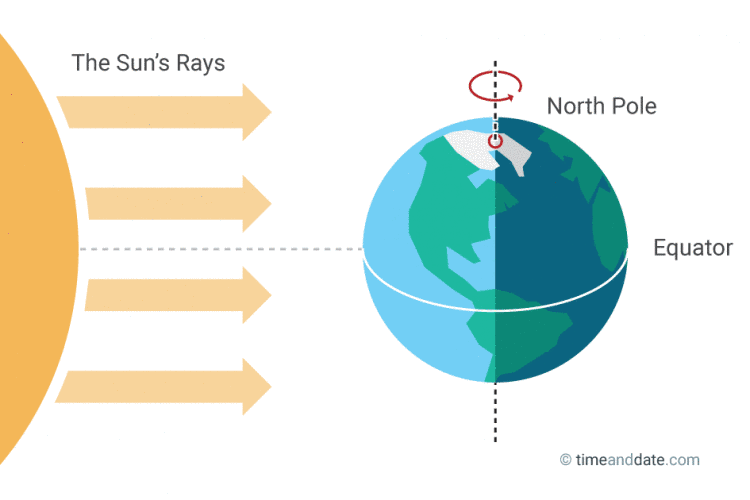On Monday, March 20, 2017,means today, the day and night will be of almost equal duration at most time zones in the world. Here are 10 facts about the March Equinox you might not know.
March Equinox is also called the Spring Equinox.

पालवी – A Jamun sapling leafing out @ Nisargshala
1. Also Autumnal Equinox
The March Equinox is known as the Vernal (spring) Equinox in the Northern Hemisphere and the Autumnal (fall) Equinox in the Southern Hemisphere.
2. First Equinox of the Year
The second equinox, the September Equinox, takes place on or around September 22 every year. It’s the Southern Hemisphere’s Spring Equinox and is called the Autumnal (Fall Equinox) in the Northern Hemisphere.
3. Marks the First Day of Spring
In the Northern Hemisphere, astronomers and scientists use the March Equinox as the start of spring, which ends on the June Solstice, when astronomical summer begins.
For meteorologists, on the other hand, spring in the Northern Hemisphere begins three weeks before the March Equinox on March 1 and ends on May 31.
4. Happens at a Specific Time All Over the World

While cultures around the world celebrate the whole day as the March Equinox. However, in reality, the equinox occurs at a specific moment in time when the Sun crosses the celestial equator, the imaginary line in the sky above the Earth’s Equator, from south to north.
At this moment, Earth’s axis is tilted neither away from nor towards the Sun, but is rather perpendicular to the Sun’s rays, like the illustration shows.
In 2017, this will happen on March 20, at 10:29 UTC.
5. The Date of the Equinox Can Vary
Remember when Spring Equinox was celebrated on March 21? Well, remember again, because the last time that happened was in 2007 and the next time it will happen is in 2101!
Contrary to popular wisdom, the March Equinox can take place on March 19, 20 or 21. In the 21st century, the March Equinox has only occurred twice on March 21 – 2003 and 2007. A March 19 equinox will be more frequent during the last decades of the century.
Note: These dates are based on the time of the equinox in UTC. Due to time zone differences, locations ahead of UTC may celebrate the March Equinox a day later, and locations behind UTC may celebrate it a day earlier.
6. Equal Day and Night…
Conventional wisdom suggests that on the equinox everybody on Earth gets to experience a day and night of equal lengths – 12 hours of daylight and 12 hours of night time. In fact, the name equinox is derived from the Latin words aequus, meaning equal, and nox, meaning night.
7. …But Not Quite
In reality though, most places on Earth get to see more daylight than night time on the equinoxes. This is because of two reasons: how sunrise and sunset is defined and atmospheric refraction of sunlight.
Most locations of the Earth, except those on the Equator, do have almost equal day and night twice a year. The dates for this event, which is also known as equilux, depend on the location’s latitude and can be a few days before or after the equinoxes.
8. Not the Only Day to Balance an Egg On Its End
Every year on the Spring Equinox, we hear about how it is the only day of the year when an egg can be perfectly balanced on its end. Many try it and those who fail are told that they didn’t try it at the exact time of the equinox. The truth, however, is that there is nothing magical about the equinox or the time it occurs – you can balance an egg perfectly on its end on any other day. Don’t believe us? Try it yourself!
9. 1 of 2 Days You Can do This Experiment
To do this experiment, you’ll need a straight stick or a long wooden ruler, a protractor and a compass.
Find an empty space such as a park or a parking lot where there are few tall buildings, trees or hills to obstruct the Sun. Find your location’s latitude. Subtract this number from 90. This will be the angle you will affix the stick in the ground.
If you are in the Northern Hemisphere, use your compass to find south and point the stick in that direction. If you’re in the Southern Hemisphere, point the stick or the ruler to the north. Using the protractor fix the stick in the ground at the angle you just calculated – remember to point it in the direction opposite to the hemisphere you are on.
Wait till Noon and see the shadow of the stick disappear. At Noon, the stick will have no shadow at all!
You can only do this experiment twice a year – on the March Equinox and the September Equinox.
10. Celebrated Around the World
Many cultures around the world hold feasts and celebrate festivals and holidays to mark the March Equinox.






One Response
Saved as a favorite, I love your blog!